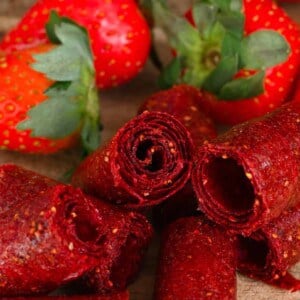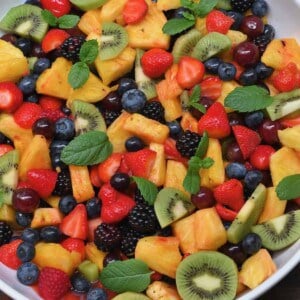This post may contain affiliate links. Please read our disclosure policy.
Learn how to make tanghulu at home – a Chinese candied fruit snack with a crunchy, sweet shell. Use my simple and easy recipe, along with my top tips and video tutorial, to coat strawberries, grapes, or your favorite fruit!

You have probably already seen these popular Chinese sugar-coated fruits. But did you know that they were very easy to make at home? My tanghulu recipe requires just a few simple steps, and you can serve these crunchy glazed fruits as a delicious dessert or midday snack.
Prepare some of these fruit skewers, easy fruit roll-ups, candied grapes, and homemade boba pearls, and you’re all set for a fun afternoon party with the kids. Perfect for any playful gathering or creative activity, these treats are sure to bring smiles all around!
Want to save this recipe?
Watch the tanghulu video
What is tanghulu
Tanghulu is a yummy candied fruit snack and popular street food from Northern China that dates back centuries. Traditionally, hawthorn fruit was treaded on a stick and was then covered in sugar syrup, turning into a delicious crunchy snack.
Since then, tanghulu recipes have become increasingly popular. Now, you can find all sorts of candied fruit—crunchy strawberries, candied grapes, and other sugar-covered fruit. When you take a bite, it makes a super satisfying crunchy sound! Then, you get a burst of fresh, juicy fruit sweetened by sugar.

Ingredients and tools needed

- Fruit: The best fruit for tanghulu is one with a firm texture, a sour or tangy flavor, and juicy inside. Choose your favorite from strawberries, grapes, blueberries, kiwi slices, orange wedges, Hawthorn berries, kumquats, cherries, apples, tangerines, pineapple, or even cherry tomatoes. These all would make an amazing crunchy snack.
- Sugar: Use white granulated sugar.
- Water:
- Tools: You’ll also need a candy thermometer or other food thermometer and metal or wooden skewers.
See the recipe card for full information on ingredients and quantities.
How to make tanghulu
Prepare the fruit: Wash and pat dry the fruit. Make sure to dry them well—we don’t want any extra moisture. Get the fruit ready: remove the green stems of the strawberries, remove grapes from their stems, and cut larger fruit like kiwi into slices or smaller bite-sized pieces.

Skewer the fruit: Then, thread each fruit onto a skewer, arranging them on one end (you will hold the skewer at the other end). You can add just one, a couple, or several fruits if using smaller berries. After testing many times, I find it’s best to work with just 1 or 2 pieces of fruit per skewer (depending on the size) because then it is easier to dip and coat them with the syrup.
Set the skewers aside. Also, fill a bowl with cold water and add a few ice cubes to make an ice bath.

Make the syrup: Add the sugar and water to a medium-sized saucepan and bring to a boil over medium heat. Do not stir so the sugar doesn’t crystalize and doesn’t form bubbles.
The sugar water mix should reach around 300°F/150°C, which is your hard crack temperature, in about 5-10 minutes as the syrup reduces and turns a nice amber color. Check the temperature occasionally with a food thermometer. While aiming for 300°F is key, don’t stress if it ticks up a few degrees—as you can see in the photo, even at 303°F, it still works beautifully. Just be cautious not to let it go much higher to avoid burning the sugar, which could affect the tanghulu’s texture and taste.

If you don’t have a thermometer, drizzle some syrup into the bowl of ice water. It should set right away and form brittle crystal threads that break easily. If they bend, the syrup is not ready.
Dip in syrup and cool in ice bath: Once the sugar mixture has reached the required temperature, remove the pot from the heat. Prepare your working station: the skewered fruit on one side, then the syrup next to them, then the ice bath, and finally, a wire rack or a tray covered with parchment paper to lay the ready candied fruit.
Take one of the tanghulu skewers and quickly dip it in the hot syrup, ensuring it is evenly coated. To make it easier, prop the pot at an angle and dip the skewer in the deep part of the syrup, or use a spoon to help cover all the fruit.
Then, immediately transfer the coated fruit to the ice-cold water to set the syrup and prevent the fruit from cooking. Then, you can place the skewer on the rack/tray to rest.

This strawberry tanghulu is far beyond just sweet. It’s perfectly coated in a glossy, transparent candy glaze—crunchy and irresistible!

Repeat the steps of dipping the fruit in the syrup and then quickly dipping it in the ice water with all your skewers. Let candied fruit rest for a few minutes on the tray. Then your homemade tanghulu is ready to enjoy!

Tips and tricks
- Use firm fruit. It stays on the skewer and won’t slide off when you dip it in syrup.
- The fruit needs to be completely dry before dipping, so make sure to dry it well after washing.
- Don’t stir the syrup. Stirring the syrup at any point—even after it reaches the hard-crack temperature—is a common candy-making mistake. It will cause the syrup to crystallize, making it cloudy instead of clear.
- Choose a saucepan with a good handle. This makes it easier to tilt and gives you enough room to dip and spin the skewers. Also, the syrup is super hot, so wear oven gloves and handle everything with caution.
- The sugar syrup must reach a temperature of 300°F for the best results. Use a kitchen thermometer for accuracy. Below this temperature, the texture will be chewy rather than crystallized.
- For best results and convenience, use one or two fruits per skewer. This makes dipping and rolling in hot syrup easier. Make sure there’s a gap between the fruit and where you hold the skewer to avoid burning your fingers. Use oven gloves for extra safety!
- Dip the fruit in the syrup and then immediately in ice-cold water to prevent the fruit from cooking. Work quickly before the syrup thickens or cools down.
- If the syrup thickens partway through, place it over low-medium heat until it becomes runny again. It may darken slightly, but that’s okay!
- To clean the pot, fill it with hot water and let it soak to loosen any hardened syrup. Then wash as usual.
How to store tanghulu
Tangulu fruit is best enjoyed right away. This way, you can enjoy the hard candy with every bite.
- To store: Place the candied fruit in an airtight container and keep it at room temperature for a few days. Make sure to keep it away from direct sunlight or humid areas.
- Avoid using nylon and plastic wrap, as this can cause the sugar coating to sweat and melt and create a sticky mess.
- Don’t refrigerate. When placed in the fridge, the fruit juices are released and will dissolve the sugar coating, causing soft and chewy results.
More fruity sweet treats
If you try this homemade tanghulu recipe, let me know how it goes in the comments below. I’d appreciate a recipe card rating and would love to see your recipe recreations – tag me on Instagram @Alphafoodie!

How to Make Tanghulu (Candied Fruit)
Equipment
- Skewers wooden or metal
- Food Thermometer optional
Ingredients
- 1 lb strawberries AND/OR blueberries, grapes, kiwi, or other fruit of choice (see Notes below)
- 2 cups white sugar
- 1 cup water
Instructions
- Wash and pat dry the fruit well with a paper towel.
- Get the fruit ready. Remove the green stems of the strawberries. Remove grapes from their stems. Cut larger fruit like kiwi into slices or smaller bite-sized pieces.
- Arrange the fruit on the skewers—it's best to thread just 1 or 2 pieces of fruit (depending on their size) and keep them at one end of the skewer. Set the skewers aside.
- Fill a bowl with cold water and add a few ice cubes to make an ice bath.
- Add the sugar and water to a medium-sized saucepan and bring them to a boil over medium heat. Do not stir!
- The temperature of the sugar syrup has to reach around 300ºF/150ºC. This takes 5-10 minutes. The syrup will start to reduce and become amber in color. Check the temperature occasionally with a thermometer (it's OK if it's a few degrees higher). Alternatively, drizzle some syrup into the bowl of ice water. It should set right away and form brittle crystal threads that break easily. If they bend, the syrup is not ready.
- Once the sugar syrup has reached the required temperature, remove the pot from the heat. You can prot the pot at an angle so it's easier to dip the skewers in the deep part.Prepare your working station: skewered fruit, the syrup next to them, the ice bath, and a wire rack or a tray covered with parchment paper on which to lay the candied fruit.
- Take one of the skewers and quickly dip it in the mixture, making sure all the fruit is coated in the sugar syrup. Immediately dip it in the ice water and lay it on the tray.
- Repeat the steps of quickly dipping the skewered fruit in the syrup and ice water until all the fruit is done. Let them rest for a few minutes on the tray.Your tanghulu is now ready to enjoy!
Video
Notes
Nutrition
Nutrition information is automatically calculated, so should only be used as an approximation.













Kind of worked but had to wait a long time to cool off. Not terrible but not excellent. Overall great!
Hi Aurora,
Thank you for your feedback.
When the tanghulu has a thin coating, it should cool down prety quickly. As soon as the shell has hardened, you can enjoy them and their crackle. I hope you give it another try!
These were perfection! But they did not store well. Put them in a plastic container with airtight top and the next morning the candy had melted off into a mess. But did enjoy the ones consumed immediately after making them.
Hi Debby,
So glad to hear you enjoyed the freshly made ones! If you’d like to try storing them next time, it’s best to keep them away from humidity. Store them in a dry, airtight container and place it in a cool, dry location. I hope this helps, and you give this recipe another try!